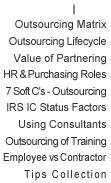Key elements of a partnering relationship
Partnering is a process, and a good partnering relationship takes time to develop and mature. It starts with a desire or reason to partner, and builds from there. The relationship must be developed over time with buy-in from both parties and clear objectives for the partnership.
A company wanting to partner with a vendor on a program should keep this goal in mind when the company begins identifying the requirements for this program. Vendors are not automatically partners.
Keys to Effective Partnering
Successful partnerships begin with a common understanding of what it takes to create a successful partnership. Both parties must be committed, and there are critical elements that must be present.
Listed below are the three keys for effective partnership, adapted from Neil Rackham’s book, "Getting Partnering Right". All three – vision, impact and intimacy – must be present in a balanced way to create an effective partnership.
Value of Partnering
Taking a partnering approach can be beneficial to both parties. Below are several examples:
- Better planning and control – in the areas of operations and user or customer experience
- Greater, more pervasive influence with the partner or client
- Loyalty and commitment to your company and product or service
- Greater speed in introducing changes, or solving problems that arise
- Greater scope for partner to be proactive
- Advance warning system on product or service issues
- Barometer of issues – in the areas of customer service and problems
- Partner is an advocate with your users or customers
- Consistent, focused experience for your users or customers
Partnering is Not for Everyone
Partnering may not apply to every vendor or client. The nature of the work may be a standard deliverable that is easily quantified and relatively constant. The vendor runs their business; the client uses their services. There is a good relationship and neither party benefits from partnering.
Not all vendors or clients see the value in partnering. This may be based on company culture, which prefers to maintain distance; or the vendor may be in a position of power to ask and get top dollar when they dominate a market, and that is their goal.
If there is value in partnering with an organization that does not share the perceived value, it is possible to create partnering relationships with key contacts that favor partnering. Or the vendor, recognizing that partnering is good business, may assign partner account managers as advocates for a client; even though the larger vendor organization does not embrace partnering.
Conversely, a top-level agreement to partner, with the right words built into the Master Agreement or an exchange of letters, may simply be a press release partnership. This type of partnership requires skilled execution at the program manager level to ensure that it works.
Summary
Approach partnering strategically – take into account the need and objectives for the partnership, the climate to sustain a partnership, its potential value and the overall viability.
© 2001 Endeavour Business Learning, 2006 Think180™
Note: To download a PDF copy of this article, go to the Think180 PDF Library page.
|


